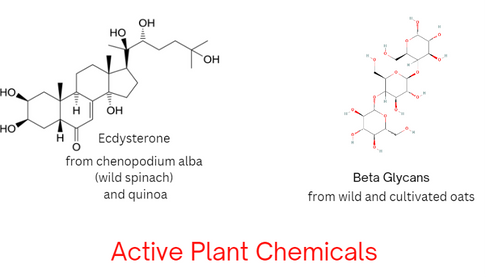The Gut and Metabolic Syndrome in Horses (EMS)...
- Carol Hughes
- Nov 14, 2023
- 6 min read
…and how the EMS Equibiome Test can provide information to aid recovery and restoration of the biome.
EMS is a common condition, especially in older or obese horses. It is also a difficult condition to manage. Many horse owners struggle to manage their horses’ diets, exercise and management regimes to keep the EMS in check and maintain a quality of life for the horse. This blog article accompanies our video on The Role of Gut Bacteria in Equine Metabolic Syndrome. Both this article and the video are based on part of the ECEIM consensus statement on EMS (see below):
''The intestine generates different types of messages via hormones and afferent nerves that inform peripheral organs (liver, adipose tissue,brain) of nutritional status, which in response generate signals to modify energy storage or expenditure.
Factors such as changes in diet or EDCs (endocrine disrupting chemicals) leading to disruption of gastrointestinal homeostasis can there-fore influence the metabolic status of the whole body. The gut microbiota has been suggested as a driving force in the pathogenesis of metabolic disease and obesity in humans and other species.
A small study of fecal microbiota in EMS and control horses showed less diversity in EMS horses with an increase in Verrucomicrobia members, which has been suggested as microbial biomarkers for pro-gression of glucose intolerance in humans.
Additionally, small changes in carbohydrate content in different cuttings of hay elicited measurable changes in equine hindgut streptococci 4 hours after meal feeding, and supplementation with short-chain fructo-oligosaccharides alters microbial populations in different parts of the intestine.''
Durham, AE, Frank, N, McGowan, CM, et al. ECEIM consensus statement on equine metabolic syndrome. J Vet Intern Med. 2019; 33: 335– 349. https://doi.org/10.1111/jvim.15423
What is Equine Metabolic Syndrome?
Equine Metabolic Syndrome (EMS) refers to metabolic and hormonal imbalances in horses, which lead to increased susceptibility to obesity, insulin resistance, and laminitis. The condition is characterised by abnormal fat distribution, heightened insulin levels, and an elevated risk of serious health complications such as laminitis.
EMS in horses is typically managed through a combination of dietary modifications, controlled exercise, and weight management. Implementing a low-starch, high-fibre diet, regular physical activity, and monitoring insulin levels all form part of the standard approach to managing EMS. Additionally, administering medications to improve insulin sensitivity and regulating pasture access may also be used to manage the condition.
The Equine Digestive System
The horse's digestive system is uniquely adapted to a herbivorous lifestyle, characterised by a relatively small stomach and sizeable hindgut. The cecum and colon play crucial roles in digesting fibrous plant material. This intricate system is notoriously sensitive to abrupt dietary changes, making gradual transitions imperative for maintaining digestive health and reducing the risk of conditions such as colic.
The Role of Gut Bacteria in Metabolic Dysregulation (EMS)
There is evidence of the role of the gut bacteria in metabolic dysregulation. For example, it has been suggested that the gut microbiota has a role in obesity and metabolic disease both in humans and other species. It has also been suggested that the gut bacteria are linked to inflammation.
“The gut microbiota contributes to the onset of metabolic dysregulations, by altering glucose and energy metabolism, leading to inflammation of the gut, adipose tissue, muscles, liver and brain.”
Geurts L, Neyrinck AM, Delzenne NM, Knauf C, Cani PD. Gut micro-biota controls adipose tissue expansion, gut barrier and glucose metabolism: novel insights into molecular targets
“The gut microbiota has been suggested as a driving force in the pathogenesis of metabolic disease and obesity in humans and other species.''
Durham, AE, Frank, N, McGowan, CM, et al. ECEIM consensus statement on equine metabolic syndrome. J Vet Intern Med. 2019; 33: 335– 349. https://doi.org/10.1111/jvim.15423
Good Metabolism Relies on a Good 3-Step Messaging System
1. During food intake, the intestine senses signals and messages from many different sources, including nutrients and metabolic hormones.
2. In response, the intestine generates its own messages (through hormones and the nervous system) informing organs and the brain about the incoming nutrients, and what type of storage and transport is needed to receive them (nutritional status).
3. This causes the organs such as the liver and adipose tissue to generate signals to modify energy storage or expenditure.
Therefore, dysregulated metabolism such as EMS could be described as the exact opposite.
Metabolic disorders characterised by an insulin resistant state are due to:
a default in nutrient sensing in the intestine
an abnormal signal from the gut sent to the peripheral organs and brain
an abnormal signal generated by the brain to the periphery
a direct insulin resistant state in the peripheral organs.
Geurts, L., Neyrinck, A. M., Delzenne, N. M., Knauf, C., & Cani, P. D. (2014). Gut microbiota controls adipose tissue expansion, gut barrier and glucose metabolism: novel insights into molecular targets and interventions using prebiotics. Beneficial microbes, 5(1), 3-17.
The messaging system that exists between the gut bacteria, intestines, and the adipose tissue triggers the onset of low-grade inflammation and is identified as a component of EMS.
The Gut Bacteria, Adipose Tissue and Inflammation
The Gut Bacteria as a Second Trigger for Inflammation Associated with EMS
Gut microbiota-derived lipopolysaccharide (LPS) is a factor involved in the early development of inflammation and metabolic diseases. Shifts in the microbiota may play a major role in inducing low-grade systemic inflammation.
Roth, P., Stanley, J., Chamoun-Emanuelli, A., Whitfield-Cargile, C., & Coleman, M. (2022). Fecal extract from obese horses induces an inflammatory response by murine macrophages in vitro. American Journal of Veterinary Research, 83(5), 419-425.
Elzinga, S. E., Weese, J. S., & Adams, A. A. (2016). Comparison of the fecal microbiota in horses with equine metabolic syndrome and metabolically normal controls fed a similar all-forage diet. Journal of Equine Veterinary Science, 44, 9-16.

Gut microbes are involved in the biosynthesis of a variety of small molecule metabolites, such as short-chain fatty acids and secondary bile acids. These metabolites with various structures and functions can be absorbed and delivered to distant organs through the circulatory system, thus playing a key role in host-microbe crosstalk.
Metabolites associated with EMS Branched chain amino acids
While we understand the importance of providing the horse with a balanced diet, a healthy microbial community in the gut can manufacture their own. Most importantly, they require plant active chemicals to degrade and turn into metabolites that actively support metabolism and host health.
Examples of active plant compounds:
Gut microbes are involved in the biosynthesis of a variety of small molecule metabolites, such as short-chain fatty acids and secondary bile acids. These metabolites with various structures and functions can be absorbed and delivered to distant organs through the circulatory system, thus playing a key role in host-microbe crosstalk.
The process of digesting food by the bacteria influences the availability of biological end products. Many of these end products have signalling functions and act to mediate the talk between the horse (host) and will eventually affect the health and physiology of the horse.
EMS Biomarkers
An increase in a group of bacteria called verrucomicrobia is seen as a biomarker for EMS
Verrucomicrobia are important members of the microbiome. They have been linked to metabolism and adipose tissue formation, exercise, and EMS by a number of studies. They are also part of the Quorum sensing mechanism. We have cited the various articles linking verrucomicrobia to these elements below:
Verrucomicrobia linked to metabolism and adipose tissue formation:
Floch, N. (2017). The influence of microbiota on mechanisms of bariatric surgery. In The Microbiota in Gastrointestinal Pathophysiology (pp. 267-281). Academic Press.
Verrucomicrobia related to exercise:
Hintikka, J. E., Munukka, E., Valtonen, M., Luoto, R., Ihalainen, J. K., Kallonen, T., ... & Pekkala, S. (2022). Gut microbiota and serum metabolome in elite cross-country skiers: A controlled study. Metabolites, 12(4), 335.
Verrucomicrobia proposed as a biomarker for EMS:
Elzinga, S. E., Weese, J. S., & Adams, A. A. (2016). Comparison of the fecal microbiota in horses with equine metabolic syndrome and metabolically normal controls fed a similar all-forage diet. Journal of Equine Veterinary Science, 44, 9-16.
Verrucomicrobia as part of the Quorum sensing mechanism:
Dicks, L. M. T. (2023). Interactions Between Gut Microbiota and the Central Nervous System, with Emphasis on Quorum Sensing Between Commensal Lactic Acid Bacteria and Human Cells.
Other Markers of EMS
Planctomycetes: The microbiome of the horse with EMS is different from those without. One research paper found higher levels of planctomycetes in horses with EMS. Planctomycetes are a normal part of the microbiome, but they have been linked to gastric inflammation (colitis) in horses at high levels. Planctomycetes are strongly antibiotic resistant, with numbers increasing following a course of antibiotics. Could antibiotics be a contributing factor to EMS?
Streptococcus, Butyrivibrio and Prevotellaceae: Obesity is a factor of EMS, and the bacteria named above have been found to increase or decrease in horses with EMS. These bacteria are efficient at harvesting nutrients from the diet and produce secondary chemicals called metabolites that contribute to the low grade inflammatory state identified as a component of EMS. The microbiome of horses with EMS will either have too many or too few (sometimes missing altogether) of the bacteria named above. To maintain a healthy balance it is important to be as close to the target levels as possible.
Biddle, A. S., Tomb, J. F., & Fan, Z. (2018). Microbiome and blood analyte differences point to community and metabolic signatures in lean and obese horses. Frontiers in veterinary science, 5, 225..
Rebalancing the Microbiome
Rebalancing the microbiome is possible once you understand and analyse the internal members of the microbial community. The EMS Equibiome test can help horse owners gain insights into their horse’s microbiome. Detecting microbial imbalances can help owners better understand how and what to feed their horses in order to restore and maintain a healthy microbiome.



























